23 November 2002: A hike up Mt. Verstovia (Peak 2550)
After almost 4 months in Sitka, I decided that it was finally time to get out and hike up a good-sized hill. I have made it up to Beaver Lake a couple of times and even hiked the bowl at the top of Harbor Mountain Road, but neither of those involves anything near the 2500+ foot elevation gain necessary to reach the top of Peak 2550 on Mt. Verstovia. The last time I hiked up Mt. Verstovia was over two years ago in August 2000. I remembered the basics of the hike, but my hiker's memory had conveniently expunged all of the parts that concerned physical discomfort. This memory lapse caused me to start out at a moderate pace around 10:30 in the morning.
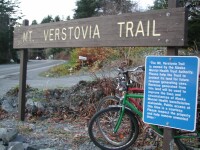 Upon starting up the trail, I found myself immediately in the forest. The
trees along the first part of the trail are second growth that has grown up
after the area was clear-cut by the Russians in the 1800s. There is still
evidence of the logging operation including charcoal pits along the trail and
a dearth of large diameter trees among other more subtle cues. Still, after
120 years or more since the cut, one must pay attention to notice the signs.
Recently there has been some concern over the potential for this area to be
clear-cut again. Much of the lower section of the trail runs through land that
is owned by the Alaska Mental Health Trust Authority. The Mental Health lands
were set aside to generate revenue to "improve the lives and circumstances of
Alaska Mental Health beneficiaries statewide." If the land were to be
clear-cut, it would be very visible from downtown Sitka. Accordingly, the
City of Sitka has been opposed to the logging, as it would presumably have a
significant negative impact on the scenic qualities of Sitka. A deal has been
made for the Forest Service to purchase the land and set it aside for
recreation.
Upon starting up the trail, I found myself immediately in the forest. The
trees along the first part of the trail are second growth that has grown up
after the area was clear-cut by the Russians in the 1800s. There is still
evidence of the logging operation including charcoal pits along the trail and
a dearth of large diameter trees among other more subtle cues. Still, after
120 years or more since the cut, one must pay attention to notice the signs.
Recently there has been some concern over the potential for this area to be
clear-cut again. Much of the lower section of the trail runs through land that
is owned by the Alaska Mental Health Trust Authority. The Mental Health lands
were set aside to generate revenue to "improve the lives and circumstances of
Alaska Mental Health beneficiaries statewide." If the land were to be
clear-cut, it would be very visible from downtown Sitka. Accordingly, the
City of Sitka has been opposed to the logging, as it would presumably have a
significant negative impact on the scenic qualities of Sitka. A deal has been
made for the Forest Service to purchase the land and set it aside for
recreation.
Although most of the trail itself is bare, there is very little bare earth to be seen alongside the trail even this late in the fall. It seems that every square inch of real estate is occupied by something living and growing. Between the trees are the larger shrubs such as salmonberry and elderberry, now devoid of leaves. Between the shrubs are smaller plants such as ferns, fern-leafed goldthread, and ground dogwood. (In the spring and summer, a variety of other herbaceous plants would be visible as well.) Covering all the other space as well as piggybacking on some of the larger plants are the mosses and lichens. It does not even stop there as molds and fungi are visible growing on the mosses and lichens. I'm sure that if my eyes had the power to resolve it, I would be able to see still smaller things growing.
I was actually a little surprised at how green the forest floor remained this late in the year. I guess that the last time I hiked around Sitka during the winter was in 1998 and at the time, I did not pay so much attention to such things. In the last few years, my experience has predominantly been in regions that were far more arid, where the ground was often bare or at most covered with woody plants that had lost their leaves and brown grasses. I am not sure if mosses actually die back in the winter or not. Some of the mosses that I looked at on this hike did seem to be dying back, while others did not. It has been a mild fall so far, and that may have something to do with staying power of some of the plants.
It did not take too long for me to (re)discover the fact that I have a tendency to out-pace my own condition. I was breathing pretty hard and decided to just sit for a bit. I could still hear the traffic from Sawmill Creek Road below me and I did not notice any birds calling. I did hear an occasional snippet of squirrel chatter and a far off dog barking, but beyond that, the only other sounds I could hear were my own breathing and an occasional push of wind through the trees. I paused many times along the first half of the trail, sometimes to investigate something that had caught my eye and other times just to relax, catch my breath, and enjoy the view.
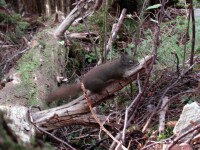 On one of the things that caught my eye was a squirrel on a log quite close to
the trail. I stopped and it did not go anywhere. I sat down behind a tree
and waited for a moment. I could hear it on the log it had been on, so I
pulled out my camera and slowly peaked around the tree to take a picture.
*Pop* went the flash and I had a fantastic picture of a washed out
tree on the right side of the frame with blackness in the background on the
left. I rarely use the flash, and so I have never really bothered to learn
how to use it right. In fact, in this instance I had not intended to use it
at all. Fortunately for me, this squirrel was stouthearted and it did not
budge from its perch. Having realized that it was probably too dark to get
a decent picture without the flash, I decided to try again with it. This
time I leaned even further out to get the tree out of the image. The results
were still too dark. Apparently, the squirrel was too far away for the flash
to provide adequate lighting. By now, the squirrel had gotten curious (and
perhaps a little concerned) about me. It decided to do a little peaking of
its own and then going out on a limb to get an even better view. I decided
to try taking a picture of the squirrel without the flash and got the ghostly
image of a quick moving squirrel seen with this paragraph. Finally,
it seemed to decide that was enough of me and my camera, so it jumped over to a
nearby tree, chattered at me briefly and then disappeared into the woods.
On one of the things that caught my eye was a squirrel on a log quite close to
the trail. I stopped and it did not go anywhere. I sat down behind a tree
and waited for a moment. I could hear it on the log it had been on, so I
pulled out my camera and slowly peaked around the tree to take a picture.
*Pop* went the flash and I had a fantastic picture of a washed out
tree on the right side of the frame with blackness in the background on the
left. I rarely use the flash, and so I have never really bothered to learn
how to use it right. In fact, in this instance I had not intended to use it
at all. Fortunately for me, this squirrel was stouthearted and it did not
budge from its perch. Having realized that it was probably too dark to get
a decent picture without the flash, I decided to try again with it. This
time I leaned even further out to get the tree out of the image. The results
were still too dark. Apparently, the squirrel was too far away for the flash
to provide adequate lighting. By now, the squirrel had gotten curious (and
perhaps a little concerned) about me. It decided to do a little peaking of
its own and then going out on a limb to get an even better view. I decided
to try taking a picture of the squirrel without the flash and got the ghostly
image of a quick moving squirrel seen with this paragraph. Finally,
it seemed to decide that was enough of me and my camera, so it jumped over to a
nearby tree, chattered at me briefly and then disappeared into the woods.
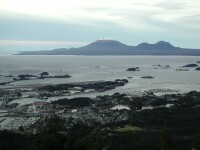 To this point in the hike, I was feeling alright. I had been sensible and
listened to my body warning me not to go too fast. Shortly after the
squirrel episode, I realized that there was someone coming up behind me on the
trail. For some reason, I felt like I needed to get to the second viewpoint
before the other hiker passed me. There was not that much distance to go,
but it was all up. I was wheezing pretty hard and my legs were feeling quite
weak by the time I reached the view point and allowed myself a break. I had
enough time to sit down and get a couple of gulps of water between gasps
for air before the hiker caught up to me and commented on the nice
view, casually took a drink of water (no gasping there), and leisurely headed
on up the trail. I find that it's always fun to have my lack of conditioning
so clearly demonstrated in this way. Needless to say, I stayed on to
appreciate the view, and by "appreciate the view," I mean, "let
my legs solidify into something stronger than a bag of warm jello." Truth be
told, there is a nice view of Sitka and Mt. Edgecumbe, but there is one
disturbing element. The coastline of Kruzof does not appear to run parallel
with the horizon. My brain seems to automatically compensate for this while
I am there looking at the view, but pictures I had taken previously turned out
looking a little crooked.
Having experienced this before, I decided to line up my picture with the
coast line of Kruzof Island and the result looked much more square to my eye.
To this point in the hike, I was feeling alright. I had been sensible and
listened to my body warning me not to go too fast. Shortly after the
squirrel episode, I realized that there was someone coming up behind me on the
trail. For some reason, I felt like I needed to get to the second viewpoint
before the other hiker passed me. There was not that much distance to go,
but it was all up. I was wheezing pretty hard and my legs were feeling quite
weak by the time I reached the view point and allowed myself a break. I had
enough time to sit down and get a couple of gulps of water between gasps
for air before the hiker caught up to me and commented on the nice
view, casually took a drink of water (no gasping there), and leisurely headed
on up the trail. I find that it's always fun to have my lack of conditioning
so clearly demonstrated in this way. Needless to say, I stayed on to
appreciate the view, and by "appreciate the view," I mean, "let
my legs solidify into something stronger than a bag of warm jello." Truth be
told, there is a nice view of Sitka and Mt. Edgecumbe, but there is one
disturbing element. The coastline of Kruzof does not appear to run parallel
with the horizon. My brain seems to automatically compensate for this while
I am there looking at the view, but pictures I had taken previously turned out
looking a little crooked.
Having experienced this before, I decided to line up my picture with the
coast line of Kruzof Island and the result looked much more square to my eye.
After recovering some semblance of mobility while convincing myself that I was just being a good photographer by taking time to compose an image properly, I half-heartedly set off up the trail. By this time, I realized that getting to the top was not going to be a physically pleasant experience in many ways. There are large steps all along the trail and together with countless other smaller steps, the elevation gains were beginning to take their toll on my body. The increase in muscle complaints led to a corresponding decrease in motivation. Had it not been so long since I hiked up to the alpine, I probably would have turned around. (On the other hand, if it had not been so long since I had hiked up to the alpine, I probably would not have felt the need to turn around.) However, I knew that I was about two-thirds of the way up and all that lay before me was a series of switchbacks which finally end on a ridge the trail follows until just before the summit.
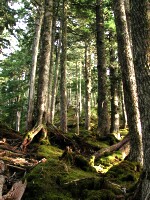 After suffering my way up the switchbacks, I topped out on the ridge. I
use the phrase "topped out" somewhat loosely, as there is still plenty of
up left before getting to the summit. It is just up which does not involve
the erosion controlling but psychologically bruising switchback. The difference
in what it feels like along the trail before it reaches the ridge and after
is significant. This significance is not due entirely to the tremendous
psychological burden that is lifted upon finally getting off of the
mind-numbing switchbacks. The ridgeline actually lies on an east-west line.
Prior to attaining the ridge, the trail is on the south side. Upon reaching
the top, it stays on top or more to the north side. At this elevation, there
is a large difference in the distribution of the flora. Trees tend to be
more widely spaced, and the ground seems to be covered with plants that
favor more moisture. This effect is presumably largely due to the lesser
amounts of direct sunlight on the north-facing side of the ridge. Similar
effects are easy to see in more arid regions where trees cover north-facing
slopes, but are absent on those that face south.
After suffering my way up the switchbacks, I topped out on the ridge. I
use the phrase "topped out" somewhat loosely, as there is still plenty of
up left before getting to the summit. It is just up which does not involve
the erosion controlling but psychologically bruising switchback. The difference
in what it feels like along the trail before it reaches the ridge and after
is significant. This significance is not due entirely to the tremendous
psychological burden that is lifted upon finally getting off of the
mind-numbing switchbacks. The ridgeline actually lies on an east-west line.
Prior to attaining the ridge, the trail is on the south side. Upon reaching
the top, it stays on top or more to the north side. At this elevation, there
is a large difference in the distribution of the flora. Trees tend to be
more widely spaced, and the ground seems to be covered with plants that
favor more moisture. This effect is presumably largely due to the lesser
amounts of direct sunlight on the north-facing side of the ridge. Similar
effects are easy to see in more arid regions where trees cover north-facing
slopes, but are absent on those that face south.
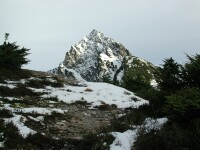 I encountered the first snow just before leaving the trees. It has been
a warm fall here and although there is snow on many of the peaks around town,
it is still not deep. There was less than an inch of snow on the ground and
many of the steps were icy from frozen snowmelt. I carefully made my way up
the steps, keeping my head down and trying to find bare gravel to step on
where it protruded from the ice. As I neared the final turn towards the top,
I happened to look up and see the snow covered main peak glistening in the
afternoon sun. This is what makes all of the physical discomfort of hiking
up a mountain worth it to me. Two hours or more of pulling myself and my
woefully heavy (I should have known I was not going to use all that stuff) pack
up the hillside collapses to a moment of... I don't know what. Whatever it is,
it's what I take back with me and remember long after the pain is gone. Much
of what I enjoy about hiking I can get by wandering around in the woods and
muskegs at low elevation where getting around is typically not so strenuous.
However, there is something that I cannot get without getting up near the top
(not even the summit, necessarily) of a mountain, and that something will keep
drawing me up again and again. (I will just have to hope that it does so often
enough that it stops being so painful to go.)
I encountered the first snow just before leaving the trees. It has been
a warm fall here and although there is snow on many of the peaks around town,
it is still not deep. There was less than an inch of snow on the ground and
many of the steps were icy from frozen snowmelt. I carefully made my way up
the steps, keeping my head down and trying to find bare gravel to step on
where it protruded from the ice. As I neared the final turn towards the top,
I happened to look up and see the snow covered main peak glistening in the
afternoon sun. This is what makes all of the physical discomfort of hiking
up a mountain worth it to me. Two hours or more of pulling myself and my
woefully heavy (I should have known I was not going to use all that stuff) pack
up the hillside collapses to a moment of... I don't know what. Whatever it is,
it's what I take back with me and remember long after the pain is gone. Much
of what I enjoy about hiking I can get by wandering around in the woods and
muskegs at low elevation where getting around is typically not so strenuous.
However, there is something that I cannot get without getting up near the top
(not even the summit, necessarily) of a mountain, and that something will keep
drawing me up again and again. (I will just have to hope that it does so often
enough that it stops being so painful to go.)
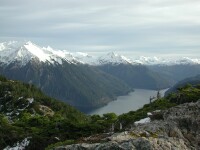 It was windy on top. Very windy. At first, it felt good to my overheated body,
but very quickly the evaporating sweat cooled me to the point that it was
unpleasantly chilly. I found a little spot that offered some protection and
ate the food that I had brought with me. As I sat, I realized that there was a
clear snow line on the mountains. It has been a long time since I have been
in Sitka when this has been the case. In the spring, summer, and early fall,
differences in tree cover and exposure to sun blur the perceived boundary
between ground that is covered in snow and ground that is not. With the first
snows confined to elevations above the tree line and no lower elevation snow
remaining from the previous winter, the snow line was quite evident. After
taking a picture do document this observation, I made my way down a ridge
away from the trail. I thought I might have heard a couple of ptarmigan near
the top on my way up, and I wanted to see if I could find any evidence of them,
or possibly even see them.
It was windy on top. Very windy. At first, it felt good to my overheated body,
but very quickly the evaporating sweat cooled me to the point that it was
unpleasantly chilly. I found a little spot that offered some protection and
ate the food that I had brought with me. As I sat, I realized that there was a
clear snow line on the mountains. It has been a long time since I have been
in Sitka when this has been the case. In the spring, summer, and early fall,
differences in tree cover and exposure to sun blur the perceived boundary
between ground that is covered in snow and ground that is not. With the first
snows confined to elevations above the tree line and no lower elevation snow
remaining from the previous winter, the snow line was quite evident. After
taking a picture do document this observation, I made my way down a ridge
away from the trail. I thought I might have heard a couple of ptarmigan near
the top on my way up, and I wanted to see if I could find any evidence of them,
or possibly even see them.
For a short distance I followed along in the tracks left by someone who appeared to have been hunting. I say this because the human tracks seemed to be following deer tracks. That may have just been coincidence, however, as the deer tracks looked like they were much older than the human tracks. I did not hear anything that sounded like ptarmigan, but I wandered down a bit further still. My path took me over a series of short (6-10 foot) drop-offs, interspersed by relatively flat ground in between. I have noticed this kind of terrain at other places in the alpine around Sitka as well. I suppose it could be coincidence, but I wonder if it has something to do with the way the ice eroded the rock during the last ice age.
When I decided to head back towards the trail, I did my best to quietly move towards a patch of trees where I thought I had heard the ptarmigan. This was not so easy due to the hardened snow. As I went, I did not notice any visible sign of ptarmigan, nor did I hear any more, so I made my way over to the trail. The shortest route to the trail involved crossing a grassy slope partially covered in icy snow. Fortunately, I was able to find enough rocks and foot-sized flat spots to avoid sliding down the hill before the official start of the sledding season. My legs were pretty rubbery after the hike up, but not so much so that I felt like getting down would be difficult.
I passed a number of other people as I made my way down the ridge towards the switchbacks. I had not progressed too far down the switchbacks when I heard some birds flitting rapidly through the trees. I had not seen them and I was interested to see what they were. I paused for a moment and listened. I heard the whirring of wings moving rapidly and looked. It appeared to be a couple of woodpeckers but they were off in an instant. I waited for a moment longer before deciding they were probably gone and starting down the trail again. After a few steps, I heard them again, but this time they were closer. At this point, I decided to get out my video camera and see if I could video tape them. While I was pulling my camera out of my pack, they flew to a tree in plain sight of me. They were clearly woodpeckers, although my bird knowledge was not enough to tell me what kind. (Further investigations at home indicate that they were either downy or hairy woodpeckers, but the species are too similar for me to be able to tell apart without a better look at the birds.) I was just about ready to start the tape when I heard some of the folks I had passed previously making their way down the trail. Two young girls and their dog came quickly down in front of the adults they were hiking with. I did not get any video of the woodpeckers and by the time all the people had passed me, the birds were gone. I waited a while just to be sure, but I did not hear them again. I am not sure what the birds were doing. It seemed like they may have been chasing each other, but I do not know why they would have been doing that.
I took my time getting down the trail in order to avoid catching up with the people who had passed me. By this time, the wind had picked up and it was pleasant to listen to the air moving through the branches as well as the trees creaking as they swayed. I noticed birds calling in the trees and thought it odd that I had not noticed any on the way up. Perhaps it was getting close enough to evening that they felt more sociable. I made it back to the trailhead by a little after 3pm and not too long before darkness.
Pictures: